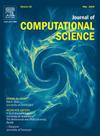Community-based voting approach to enhance the spreading dynamics by identifying a group of influential spreaders in complex networks
IF 3.7
3区 计算机科学
Q2 COMPUTER SCIENCE, INTERDISCIPLINARY APPLICATIONS
引用次数: 0
Abstract
Exploring a group of influential spreaders to acquire maximum influence has become an emerging area of research in complex network analysis. The main challenge of this research is to identify the group of important nodes that are scattered broadly, such that the propagation ability of information is maximum to a network. Researchers proposed many centrality-based approaches with certain limitations to identify the influential nodes (spreaders) considering different properties of the networks. To find a group of spreaders, the VoteRank (a voting mechanism) based method produces effective results with low time complexity, where in each iteration, the node votes for its neighbors by its voting capability, and the node obtaining the maximum vote score is identified as an influential spreader. The major loophole of existing VoteRank methods is measuring the voting capability based on the degree, k-shell index, or contribution of neighbors methods, which does not efficiently identify the spreaders from the diverse regions based on their spreading ability. In this paper, we propose a novel Community-based VoteRank method (CVoteRank) to identify a group of influential spreaders from diverse network regions by which the diffusion process is enhanced. Firstly, we measure every node’s spreading ability based on intra- and inter-connectivity structure in a community, which signifies the local and global importance of the node. To identify the seed nodes, we assign the spreading ability to that node’s voting capability and iteratively calculate the voting score of a node based on its neighboring voting capability and its spreading ability. Then, the node acquiring the maximum voting score is identified as the influential spreader in each iteration. Finally, to solve the problem of influence overlapping, CVoteRank reduces the voting capability of the neighboring nodes of the identified spreader. The efficiency of CVoteRank is evaluated and compared with the different state-of-the-art methods on twelve real networks. Utilizing the stochastic susceptible–infected–recovered epidemic method, we calculate the infected scale, final infected scale, and the average shortest path length among the identified spreaders. The experimental results show that CVoteRank identifies the most efficient spreaders with the highest spreading ability within a short period and the maximum reachability, and the identified spreaders are situated at diverse portions of the networks.
基于社区的投票方法通过识别复杂网络中有影响力的传播者群体来增强传播动态
探索一群有影响力的传播者以获得最大的影响力已成为复杂网络分析中的一个新兴研究领域。本研究的主要挑战是如何找出一组分布广泛的重要节点,使信息在网络中传播的能力最大。考虑到网络的不同特性,研究者提出了许多基于中心性的方法来识别有影响的节点(传播者),但这些方法有一定的局限性。为了寻找一组传播者,基于VoteRank(一种投票机制)的方法产生了低时间复杂度的有效结果,其中在每次迭代中,节点根据其投票能力对其邻居进行投票,获得最大投票分数的节点被识别为有影响力的传播者。现有VoteRank方法的主要漏洞是基于程度、k-shell指数或邻居方法的贡献来衡量投票能力,不能有效地根据传播能力从不同区域中识别出传播者。本文提出了一种基于社区的VoteRank方法(CVoteRank),从不同的网络区域中识别一组有影响力的传播者,从而增强传播过程。首先,我们根据社区内部和内部的连通性结构来衡量每个节点的传播能力,这表明了节点的局部和全局重要性。为了识别种子节点,我们将传播能力分配给该节点的投票能力,并根据相邻节点的投票能力和传播能力迭代计算节点的投票得分。然后,在每次迭代中,将获得最大投票分数的节点识别为有影响力的传播者。最后,为了解决影响重叠的问题,CVoteRank降低了被识别的传播者相邻节点的投票能力。在12个真实网络中,对CVoteRank的效率进行了评估,并与不同的先进方法进行了比较。利用随机易感-感染-恢复流行病方法,我们计算了感染规模、最终感染规模和确定的传播者之间的平均最短路径长度。实验结果表明,CVoteRank能够识别出在短时间内传播能力最强、可达性最大、效率最高的传播体,并且识别出的传播体分布在网络的不同位置。
本文章由计算机程序翻译,如有差异,请以英文原文为准。
求助全文
约1分钟内获得全文
求助全文
来源期刊

Journal of Computational Science
COMPUTER SCIENCE, INTERDISCIPLINARY APPLICATIONS-COMPUTER SCIENCE, THEORY & METHODS
CiteScore
5.50
自引率
3.00%
发文量
227
审稿时长
41 days
期刊介绍:
Computational Science is a rapidly growing multi- and interdisciplinary field that uses advanced computing and data analysis to understand and solve complex problems. It has reached a level of predictive capability that now firmly complements the traditional pillars of experimentation and theory.
The recent advances in experimental techniques such as detectors, on-line sensor networks and high-resolution imaging techniques, have opened up new windows into physical and biological processes at many levels of detail. The resulting data explosion allows for detailed data driven modeling and simulation.
This new discipline in science combines computational thinking, modern computational methods, devices and collateral technologies to address problems far beyond the scope of traditional numerical methods.
Computational science typically unifies three distinct elements:
• Modeling, Algorithms and Simulations (e.g. numerical and non-numerical, discrete and continuous);
• Software developed to solve science (e.g., biological, physical, and social), engineering, medicine, and humanities problems;
• Computer and information science that develops and optimizes the advanced system hardware, software, networking, and data management components (e.g. problem solving environments).
 求助内容:
求助内容: 应助结果提醒方式:
应助结果提醒方式:


